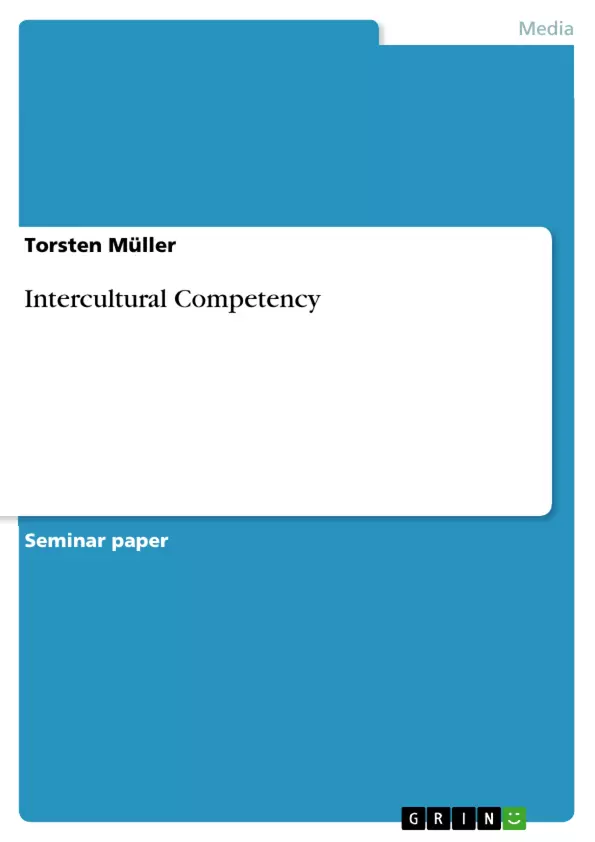One might think that intercultural competency refers especially to sociopolitical aspects. But as a matter of fact, “intercultural competence refers to the real world in which we live and act, the world we have created together and continue to re-create daily” [Dea06, p. 6], as Dr. Darla K. Deardorff defines it in her work “Intercultural Competence – The Key Competence in the 21st Century?” Therefore, and that’s how she keeps on arguing, “the acquisition of intercultural competence is a continual, dynamic process, one that moves through diverse dimensions while developing and enriching itself in an upward spiral” [Dea06, p. 6]. That means that it is an ongoing development which is not restricted to any kind of area or group. The premises for intercultural competency are according to Deardorff “a general openness for and appreciation of cultural diversity and an ability to encounter and deal with individuals from foreign cultures in an open, curious and unprejudiced manner” [Dea06, p. 8]. A cultural education, for example, would promote all these skills. Thus, it is not especially speaking a foreign language, but much more “an understanding of others world views; an understanding of the role and impact one’s culture has on behavior and communication as well as historical and religious contexts; and a sociolinguistic awareness of the relation between language and meaning in a societal context” [Dea06, p. 8], as Deardorff describes it. So, if you do not speak any foreign language, you can still demonstrate intercultural competency by presenting at least one of the mentioned abilities. And always remember, even in silence you are still conveying signals that communicate with others. It is impossible not to communicate. The most important thing, however, is not to be afraid of other cultures or even reject them. Then you will see, on the one hand, that every culture has its beautiful sides and you will get to know great people with ease and, on the other hand, they will appreciate your openness and thoughtfulness immediately. So we can say that intercultural competency is very crucial in our modern world of globalization.
Table of Contents
- What is Intercultural Competency?
- Why is body language that important for intercultural understanding and commitment? Use the arguments in the text to underline your statements!
- How can the use of body language influence negotiation success? Please illustrate the main key success factors for negotiations and work out the impact and influence body language has on them.
- Your study material explains the different expectations to men and women in different cultures. Explain how body language influences these role expectations and how individuals could deal with it.
- Body language makes things more complex – and maybe more difficult. How could you deal with different cultural expectations in situations which do not allow any body language, e.g. in emailing? Please work out the theoretical aspects first, and then give two examples out of the business world.
Objectives and Key Themes
This document aims to explore the significance of intercultural competency, focusing on the role of body language in cross-cultural interactions. It analyzes how understanding and utilizing body language can enhance communication, negotiation success, and overall understanding between individuals from different cultural backgrounds.- The importance of intercultural competency in a globalized world.
- The role of body language in conveying cultural norms and individual emotions.
- The impact of body language on negotiation success and interpersonal communication.
- Cultural differences in body language expectations for men and women.
- Strategies for navigating cultural differences in communication, particularly in situations where verbal communication is limited.
Chapter Summaries
- This chapter defines intercultural competency as a dynamic process of understanding and appreciating cultural diversity. It emphasizes the importance of openness, curiosity, and awareness of cultural influences on behavior and communication.
- This chapter explores the significance of body language in cross-cultural interactions. It highlights the need for understanding and respecting different cultural norms regarding gestures, expressions, and greetings. The chapter also discusses how body language reveals deeper aspects of a person, including their thoughts, emotions, and attitudes.
- This chapter focuses on the role of body language in negotiation success. It analyzes how nonverbal cues can influence the effectiveness of communication, build trust, and convey confidence. The chapter emphasizes the importance of eye contact, posture, and the interpretation of nonverbal signals in negotiation scenarios.
- This chapter delves into the cultural differences in expectations regarding men and women's body language. It highlights how societal norms and gender roles influence nonverbal communication, leading to potential misunderstandings. The chapter explores strategies for navigating these differences and fostering effective communication.
Keywords
This paper examines the concept of intercultural competency, focusing on the role of body language in effective communication and negotiation. Key areas of exploration include cultural norms, nonverbal communication, negotiation tactics, gendered body language, and strategies for navigating cultural differences in a globalized context.- Quote paper
- Torsten Müller (Author), 2012, Intercultural Competency, Munich, GRIN Verlag, https://www.grin.com/document/210635



